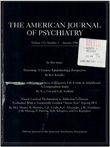Assessing positive and negative symptoms in children and adolescents
Abstract
OBJECTIVE: The purpose of this study was to test the reliability and validity of a new assessment instrument for positive and negative symptoms in severely disturbed children and adolescents (Kiddie-PANSS). METHOD: The Positive and Negative Syndrome Scale for adult schizophrenia was modified through successive field trials on the basis of developmental characteristics of children and adolescents. The scale was then given to 34 inpatients (19 children, mean age = 9.35 years, and 15 adolescents, mean age = 14.33 years) with DSM-III-R diagnoses of schizophrenia, psychosis not otherwise specified, schizoaffective, affective, conduct, personality, and developmental disorders determined independently by child psychiatrists. All patients with schizophrenia were placed in the schizophrenic group, and all others were placed in a general inpatient group. The Kiddie-PANSS ratings were given by three trained child psychiatrists after a 30-35-minute structured interview. The Achenbach Child Behavior Checklist, the Scale for the Assessment of Positive Symptoms, and the Scale for the Assessment of Negative Symptoms were also administered in order to determine criterion-related association. RESULTS: Intraclass correlation coefficients revealed that all subscales and total psychopathology were reliably assessed among raters. The Kiddie-PANSS and Scale for the Assessment of Positive Symptoms/Scale for the Assessment of Negative Symptoms correlated with one another, indicating criterion-related association. Differences on measures of positive, negative, and general psychopathology, as measured by the Kiddie-PANSS, between the patients with schizophrenia and the general inpatient group were highly significant. CONCLUSIONS: The Kiddie-PANSS shows good interrater reliability and criterion- related validity. In a cohort of inpatient children and adolescents the scale successfully differentiated schizophrenic patients from nonschizophrenic patients.
Access content
To read the fulltext, please use one of the options below to sign in or purchase access.- Personal login
- Institutional Login
- Sign in via OpenAthens
- Register for access
-
Please login/register if you wish to pair your device and check access availability.
Not a subscriber?
PsychiatryOnline subscription options offer access to the DSM-5 library, books, journals, CME, and patient resources. This all-in-one virtual library provides psychiatrists and mental health professionals with key resources for diagnosis, treatment, research, and professional development.
Need more help? PsychiatryOnline Customer Service may be reached by emailing [email protected] or by calling 800-368-5777 (in the U.S.) or 703-907-7322 (outside the U.S.).



